There’s a new artificial intelligence tool that has been generating quite a bit of buzz among teachers. It’s called Brisk Teaching, and it functions through the use of a Google Chrome extension. Brisk Teaching’s website claims that it’s the number one AI-powered Chrome extension and that it helps to automate your workload without adding to it. Brisk Teaching includes a suite of teaching assistants and writing feedback tools.
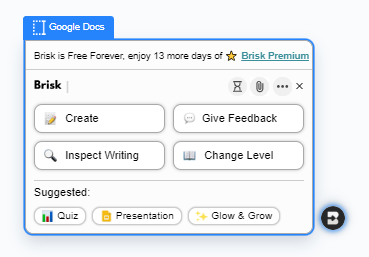
Getting Started
To access Brisk Teaching, open your Chrome browser and navigate to briskteaching.com. Then, choose the Add to Chrome for Free option. This will take you to the Chrome Web Store, where you can add the extension. Follow the prompts and install the extension. Once it is installed, you will want to make sure that you pin it to your toolbar for easy access. If the Brisk circle icon does not appear in the lower-right corner of your screen, you may need to restart the browser to activate the plug-in.
Once the “Brisk” button appears, all you need to do is click on the little icon and the Brisk menu will pop up.
An Overview of the Brisk Tools
Currently, there are six categories of AI assistant tools available in the Brisk ecosystem, and they are all very nicely aligned with common teaching tasks.
Create Instructional Materials in Seconds:
- AI Lesson Plan Generator
- DOK (Depth of Knowledge) Questions
- AI Rubric Generator
- AI Quiz Maker
- AI Presentation Maker
- Teacher Exemplar
- Teaching Resource Maker
- Something Else
- Decodable Texts
- State Practice Tests (STAAR, SBAC)
- AI Syllabus Generator
- Progress Report Maker
- UDL (Universal Design for Learning) Lesson Plan
Instantly Manage Administrative Tasks:
- AI Email Writer
- AI Newsletter Generator
- Letter of Recommendation Generator
- Observation Notes
Rapidly Develop Student Interventions:
- MTSS (Multi-Tiered System of Supports) Creator
- MTSS Template
- IEP (Individualized Education Program) 504 Template Maker
- AI IEP Goal Generator
Effortlessly Provide Impactful Feedback:
- Targeted Feedback Generator
- Glow & Grow Feedback
- Next Steps Feedback
- Rubric Criteria Feedback
- Feedback Insights Tool
Quickly Evaluate Student Writing
- Inspect Writing
Easily Adjust and Translate Texts:
- Text Leveler Tool
- Translate Text Tool
To give you a sense of Brisk’s functionality, this review will look at five of the most popular AI options the program has to offer. If you like what you see here, you can install Brisk and try these and other features for yourself.
A Review of the Top Brisk AI Tools
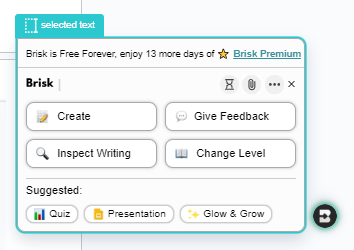
To use this tool, open a student paper and click the “Inspect Writing” button. You will immediately see a video playback on your screen showing the creation of the document. It runs in faster than real time, so you can scan the process quickly. As it plays, you can watch as content is typed, edited, and copied and pasted into the document.
This is a valuable feature as it can provide you with insight into each student’s writing workflow and process. You can see through the replay if content has been typed little by little or if it was simply pasted into the document as one big section from another source. If a student turns in a paper with just a few edits, or maybe none at all, that would be a little suspicious and could warrant a conversation with the student about how they wrote their paper.
In addition to the video playback, you can click on the magnifying glass icon at the top to run an AI detection inspection of the student’s writing. The AI detection results in a score on a sliding scale that ranges from Unlikely for AI Writing to Likely for AI Writing.
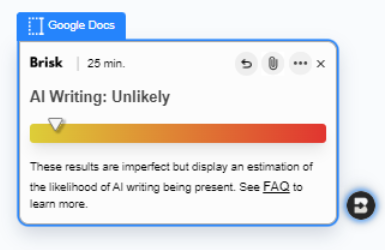
Use this feature with caution as AI detectors are notoriously inaccurate and often produce false positives. Rather than using this as a definitive screening tool, it is a better practice to reference it as one more data point about a student’s writing. If you suspect that a student used AI to write a paper or that they simply copied and pasted writing from another source, you can use the video playback or detection results to frame your conversation with the student.

Providing feedback on student writing is an incredibly time-consuming task. At the same time, providing targeted and timely feedback is one of the most important ways that you can help your students improve their writing. That’s where this tool can be helpful. It can aid you in providing some of that feedback and free you up to personally conference with students about their writing.
To run the feedback generator, you will first open a student’s Google Doc. Once you have it open, you can choose from a variety of feedback choices. One of those options is Glow & Grow Feedback. When you click this button, a pop-up menu will prompt you to put in a description of what you want the AI to focus on. For example, you could instruct the AI to examine the student work for fluency, coherence, originality, and formatting.
You will also have the option to choose a target language and grade level. You may even attach a rubric or align the scan to specific academic standards. Using these options can help the AI provide more accurate and targeted feedback.
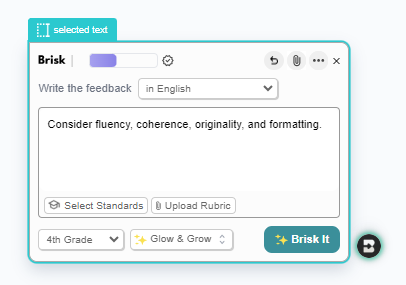
Once you have made your selections, click the “Brisk It” button. Brisk will almost immediately begin providing feedback. It will give you approximately three glows, three grows, and three wonderings for the student to consider about the writing on the selected Google Doc. As the teacher, if you like the AI-generated feedback, you can copy the responses and paste them into the document for the student to review. If the provided feedback doesn’t meet the mark, you can ask follow-up questions or provide suggestions in the text field at the bottom of the results.
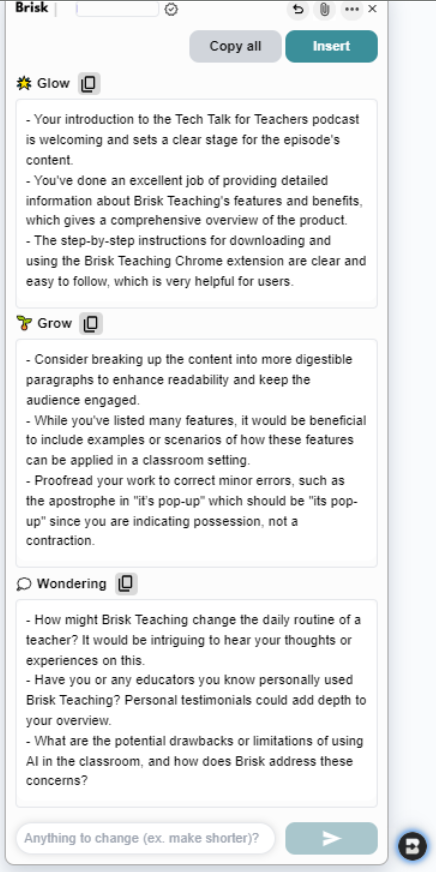
It’s best to not totally rely on AI for student feedback, as that can disconnect you too much from the review process. Instead, you can use a tool like Brisk to give students an initial round of feedback, freeing you up to have conversations and coaching sessions with your students. Rather than waiting with no feedback while you make the rounds, Brisk can help get your students started on the review and revision process.
In addition to the Glow & Grow Feedback feature, there are three other feedback options that you can explore:
- Feedback based on each criteria from a rubric that you attach
- Next steps, which offers suggestions to students
- Targeted feedback, which is only available in the premium version of Brisk, highlights passages based on identified criteria, and then posts those comments in the margin using Google’s comment feature
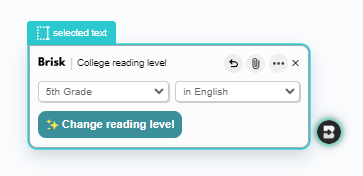
This option lets you change the reading level of the text in a document. Simply choose the grade level and click the “Change reading level” button. Brisk will create a new document with a new version of your file. It will also provide a link at the top of the new document back to the original document, so the student can review the original text if they desire.
Once the reading level has been changed, you will be offered a series of additional revision options: changing the length, adding or deleting detail, and translation. With the click of a button, you can have the text revised again according to these new choices. This can be a huge time-saver for anyone needing to create differentiated text for different levels of readers.

This button is packed with all the teacher tools available in Brisk. It includes everything from lesson planning to presentation creation to administrative task assistance.
The presentation creator is a popular feature. If you choose this option, you will be prompted to select a language and a template style. You can also attach standards, choose a grade level, indicate a number of slides to be produced, and whether or not you would like Brisk to include images. The main text area will prompt you to describe the topic of your presentation so that it knows what to create. You could type in an outline or attach your content in the form of another document. You can also simply tell Brisk to use the content in the current Google Doc that you have open.
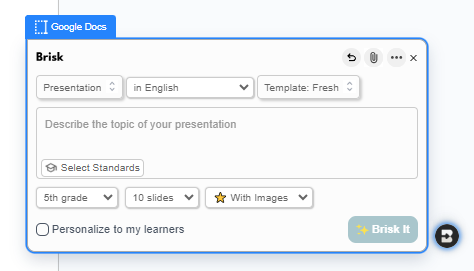
When you click the “Brisk It” button, you will be prompted to allow access to Google Slides. Once you do this, Brisk will immediately begin building your slideshow. You will see slides appear in real time. Each generally includes a title, image, and bullet points. While you may not like everything that the AI creates, it can give you a nice starting point upon which to build.
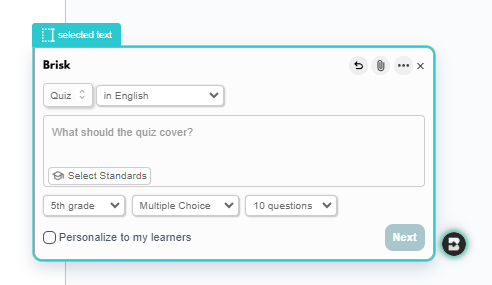
When you initiate the this generator of quizzes, you will view a screen that allows you to choose the grade, question type, number of questions, and language. Once again, you can choose to upload standards or type in a summary of what you want generated. Brisk will ask you if you want the questions added to the current document or put into a new Google Form that can be used with students.
If you choose to put them into the Google Doc, Brisk will paste the questions at the bottom of your open document. The correct answers will not be indicated in this version. If you choose the Google Form option, you will again need to grant permissions, and then Brisk will create a quiz in a new Google Form. It will not only create the questions, but it will also tag the correct answers for auto-grading.
Once the quiz has been generated, Brisk will ask you if you want to add any short-response, long-response, or additional multiple-choice questions. The whole process is quite fast and easy.
AI assistants are quickly changing how teachers do their work. They are saving time and offering insights into how the teaching and learning process can continue to evolve. Brisk Teaching is one such option. Others that are popular include MagicSchool and SchoolAI. Each offers slightly different functionality and workflows. The key is to find what works for you and start experimenting.
AVID Connections
This resource connects with the following components of the AVID College and Career Readiness Framework:
- Instruction
- Rigorous Academic Preparedness
- Student Agency
- Insist on Rigor
- Break Down Barriers
- Align the Work
- Advocate for Students
Extend Your Learning
- Brisk Teaching (official website)
- MagicSchool (official website)
- SchoolAI (official website)
